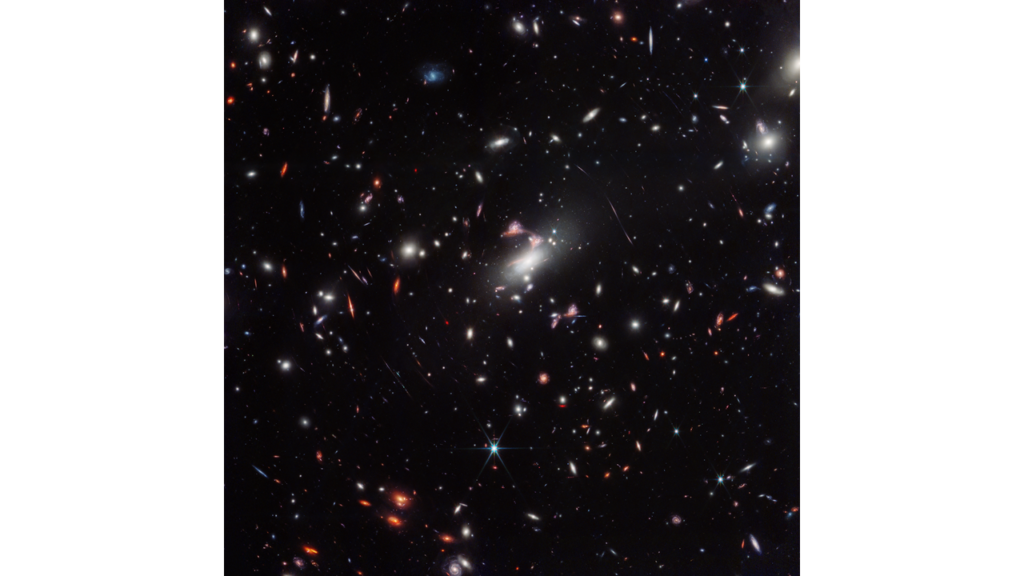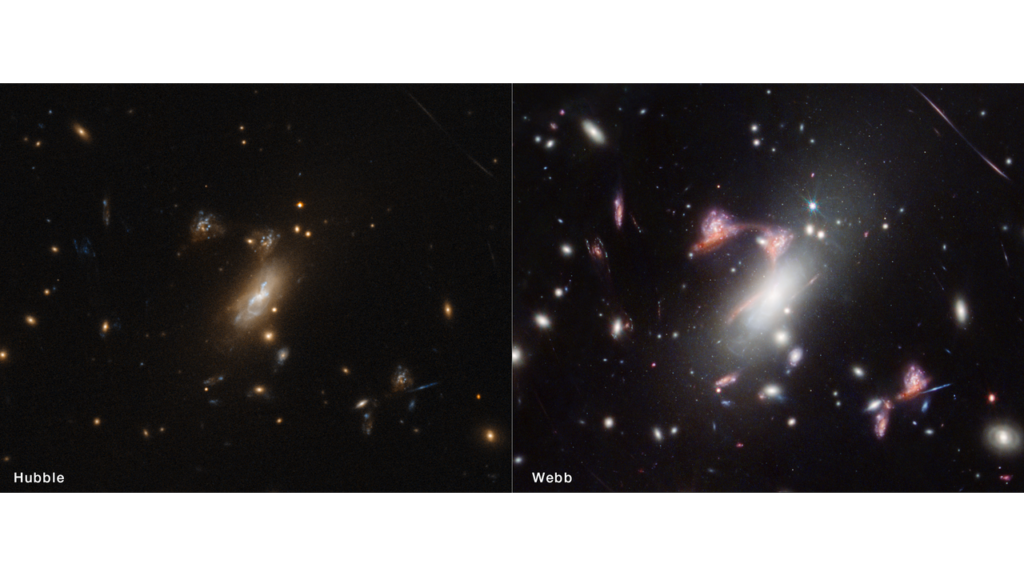The James Webb Space Telescope (JWST), known for its unprecedented ability to peer deep into the universe, has once again captured the imagination of astronomers and the public alike. This time, it has revealed a unique cosmic phenomenon—a “question mark” shape created by gravitational lensing. The cosmic question mark is more than just an intriguing visual; let’s unravel the understanding of the dynamics of galaxy formation and the forces that shape them.
What is Gravitational Lensing and Its Importance?
Gravitational lensing is a phenomenon where a massive object, like a galaxy cluster, bends the fabric of space-time, causing the light from objects behind it to curve and magnify. This process acts as a natural cosmic magnifying glass, allowing astronomers to see distant galaxies that would otherwise be hidden from view. In the case of the recent discovery, the galaxy cluster MACS-J0417.5-1154 is so massive that it warps the space-time around it, distorting the appearance of galaxies located behind it.

According to NASA, gravitational lensing magnifies these distant galaxies and causes them to appear multiple times in images. This lensing effect is critical for astronomers because it helps them observe the most distant and faint galaxies, shedding light on the early universe’s conditions and the processes that governed galaxy formation. The ability of JWST to capture these rare alignments, like the cosmic question mark, is a testament to its advanced technology and its crucial role in unlocking cosmic secrets.
A Rare Cosmic Alignment Creates a “Question Mark”
The discovery of the “question mark” shape is the result of a rare cosmic alignment between distant galaxies, a massive lensing cluster, and the observer here on Earth. As reported by astronomer Guillaume Desprez of Saint Mary’s University in Halifax, Nova Scotia, this configuration is extremely rare, with only three or four similar instances known in the observable universe. This makes the discovery not just visually intriguing but scientifically significant.
The “question mark” was formed by the combined gravitational lensing effect of the massive galaxy cluster MACS-J0417.5-1154 and two distant, interacting galaxies: a face-on spiral galaxy and a dusty red galaxy seen from the side. The gravitational lens created an optical illusion that resulted in multiple images of these galaxies tracing a familiar shape across the sky. The dot of the question mark is actually another unrelated galaxy that happens to be in just the right position in space-time from our perspective. This rare alignment provides astronomers with a unique opportunity to study the physical properties of these galaxies and understand how they interact with one another.
Insights into Early Universe and Star Formation
This discovery is not just about an unusual visual phenomenon; it provides vital insights into the processes that govern galaxy evolution and star formation in the early universe. The images captured by JWST show active star formation in several compact regions within both the face-on spiral galaxy and the dusty red galaxy. Vicente Estrada-Carpenter of Saint Mary’s University emphasized the importance of such observations, noting that “knowing when, where, and how star formation occurs within galaxies is crucial to understanding how galaxies have evolved over the history of the universe.”
Using both Hubble’s ultraviolet data and JWST’s infrared capabilities, the researchers were able to identify star-forming regions that are otherwise hidden by cosmic dust. The spectral data also confirmed that the newfound dusty red galaxy is located at the same distance as the face-on spiral galaxy, indicating that they are likely beginning to interact. This interaction is a key area of study because it can provide clues about how galaxies merge and evolve over time. The relatively intact shape of both galaxies suggests that this is the early stage of their interaction, providing a glimpse into a process that could lead to more dramatic changes in their structure.
Hubble vs. Webb: A Technological Leap
The discovery of the cosmic question mark also highlights the technological leap between the Hubble Space Telescope and the James Webb Space Telescope. While Hubble has been instrumental in studying the universe for over three decades, JWST’s advanced infrared imaging capabilities allow it to see through cosmic dust and capture details that Hubble could not. A side-by-side comparison of the same region of space shows how JWST’s images are more colorful, defined, and detailed compared to Hubble’s more muted and hazy views.

The ability to detect structures hidden behind cosmic dust is crucial for astronomers studying distant galaxies and star-forming regions. JWST’s Near-Infrared Imager and Slitless Spectrograph (NIRISS) instrument, in particular, has demonstrated its capability to detect star formation in galaxies billions of light-years away. As Marcin Sawicki of Saint Mary’s University noted, “Amazing images like this are why I got into astronomy when I was young.” The JWST’s superior imaging quality is not just a leap in technology; it’s a leap in our ability to understand the universe.
The Future of Cosmic Discoveries
The cosmic question mark is a tantalizing hint of what is yet to come. The discovery is part of the Canadian NIRISS Unbiased Cluster Survey (CANUCS), which aims to use JWST to study galaxy clusters and their effects on background galaxies. This ongoing research is expected to provide more insights into galaxy formation, star formation rates, and the distribution of dark matter in the universe.
The potential for future discoveries is enormous. By studying these rare alignments and the resulting gravitational lenses, astronomers hope to unlock more secrets about the universe’s early days, when star formation was at its peak. The cosmic question mark is just the beginning. As JWST continues to observe the universe in unprecedented detail, we can expect to uncover more cosmic phenomena that challenge our understanding and inspire new lines of inquiry.
Conclusion: A Glimpse into the Teenage Years of the Universe
The cosmic question mark revealed by the James Webb Space Telescope is more than just a visual curiosity. It is a powerful reminder of the complexity and beauty of the universe. This discovery not only demonstrates the capabilities of JWST but also provides a unique opportunity to study galaxy interactions, star formation, and the early universe’s dynamics. As astronomers continue to study this phenomenon and others like it, we are gaining valuable insights into the “teenage years” of galaxies, including our own Milky Way.
The universe is full of mysteries waiting to be uncovered, and the James Webb Space Telescope is opening new windows to explore them. As we gaze upon the cosmic question mark, we are reminded of the endless possibilities that lie ahead in our quest to understand the cosmos. Who knows what other cosmic wonders await discovery? One thing is certain: with JWST, we are only just beginning to scratch the surface of what the universe has to offer.
Reference:
Unveiling the Cosmic Question Mark: Gravitational Lensing in Galaxy Cluster MACS-J0417.5-1154 with JWST and HST Observations. retrieved from https://science.nasa.gov/missions/webb/nasas-webb-reveals-distorted-galaxy-forming-cosmic-question-mark/



















